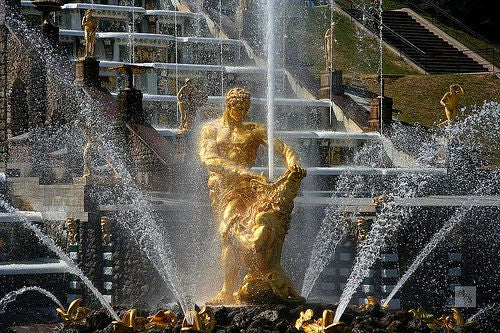
When Were Water Fountains Invented
The actual origins of water fountains are unknown, however, they have a long history dating back thousands of years. Decorative water features can be linked back to ancient cultures like the Egyptians, who built elaborate fountain-like structures in their courtyards and sanctuaries. However, the first recorded mechanical water feature dates back to the 6th century BC in ancient Greece. These primitive fountains used gravity and crude hydraulic devices to generate flowing water displays.
Water fountain designs grew and flourished over time in numerous cultures, including the majestic Roman Empire fountains. Water features continue to fascinate and amaze today, functioning as both practical and artistic aspects in public and private landscapes alike, carrying on a centuries-old heritage.
The World’s Oldest Fountains
Outdoor fountains are a stunning piece of engineering that can be enjoyed by millions of people. Some are purely tourist attractions while others served a purpose for filtering water or even as a memorial.
While you might think fountains are a relatively modern invention, with fantastic displays in Las Vegas and Singapore immediately springing to mind, mankind has been building and admiring fountains for centuries.
Some of the world’s oldest fountains are still working as well as they did when they were first built proving that if something is designed and built well, it can stand the test of time.
Versailles Fountain, France

The fountains at the Palace of Versailles is one of the most beautiful places to visit. Sat within 800 hectares of pristine grounds, there are 50 fountains which have 620 water jets.
While the garden itself was created in 1632 after Louis XIII bought the land, it was some years later, in 1664, that the fountains began to be built.
There are several ornate fountains around the gardens all named – some after Greek gods. Bacchus, Latona, Saturn, Apollo, Flora, Ceres, Neptune, Mirror, Dragon and the Nymphs bath are all dotted around this huge garden.
Samson and the Lion Fountain, Russia

Louis XIV also inspired this incredible fountain sitting at the Peterhof Palace in St Petersburg, Russia. This fountain really tells a story. The centre of the water jets tells a story moulded out of stone.
There are 64 fountains which fall into the pool and has been in place since 1730. The Samson Fountain shows the moment Samson defeats the lion which is meant to symbolise Russia’s victory over Sweden during the Great Northern War.
A lion was chosen as it appears on the Swedish coat of arms and what some would say was the turning point of the war was St Samson’s Day.
This impressive fountain shoots water 20 metres in the air from the lion’s mouth. Incredibly, this is achieved without modern technology. Water fills reservoirs around the fountain at an elevated height. It’s this height that uses gravity to create pressure and then power the fountains.
The Hundred Fountains, Italy

This incredible water feature combines water jets and planting to create a leafy, lush wall with a beautiful sound of its own.
Located in Tivoli, these fountains are part of the Villa D’Esta and are a must see attraction if you ever find yourself in that part of the world.
Carved animal heads and ornate figures pour water from their mouths into two running troughs which sit one on top of the other. Atop that is a selection of water jets spraying different patterns into the air. The effect is wonderful and the noise of rushing water can be heard from the moment you arrive at the villa.
In the central square, a huge fountain sits in the centre of a pool surrounded by a curved wall climbing with ivy and other rambling plants.
The villa itself is one of the best Renaissance residences in existence and definitely one of the more luxurious.

